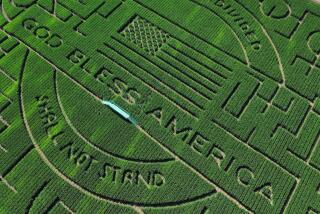Summer jobs still sprout in a fertile field : With youth fleeing the farm, seed producers must recruit seasonal labor from the city.
- Share via
DURANT, Iowa — Only 16, Mark (Mad Dog) Chapman might still be considered a little wet behind the ears. But there he was the other day, groping feverishly for another dangling tassel in a venerable Farm-Belt fertility rite.
Wait. We’re not violating family-newspaper standards here. We’re talking corn. Maize. The tall, green plant with the big ears and the little yellow kernels.
Anyway, Mad Dog--so nicknamed for the fierce way he tears into his work--is one of tens of thousands of Midwestern teen-agers performing a critical, curious and backbreaking summer ritual known as detasseling. For two to three weeks each July, just before the crop is ready to pollinate, they fan out in selected cornfields throughout the region and methodically yank the tassels from the tops of the stalks.
The idea is to tinker with the plant’s reproductive process, but don’t waste breath trying to explain that to Mad Dog. He’s in it for the money and the fringe benefits. “It’s outdoors; you get sun and you can look at the girls,” he said with a grin.
Detasseling jobs have been a staple of summertime, not to mention a primary source of pocket change, for generations of farm youths dating back to the emergence of hybrid strains of corn during the Depression.
“For many kids it was a first job,” said Chuck Kuster, an executive in charge of detasseling recruitment for Pioneer Hi-Bred International Inc., a leading producer of seed corn. “It gave them a way to make some money and still have time to be a kid and play baseball or go swimming.”
In essence, detasseling is low-tech genetic engineering. Left untouched, corn plants self-pollinate. The tassel, the top 16- to 20-inch male portion of the plant, emits pollen that wafts through the air to be captured by silks on the ear, the female end. Most commercial crops of sweet and field corn--the stuff that people and pigs eat--are still fertilized this way.
Every year, suppliers such as Pioneer also grow a smaller, separate crop just to produce the seeds that farmers will plant in the next growing season. This year’s seed crop makes next year’s commercial crop. To ensure quality and uniformity, seed corn requires special care.
Typically, two pure parent strains, perhaps one that is more drought resistant and another that produces superior yield, are planted in the same field. When the tassels are removed from one of the varieties it gets pollinated by the other. In effect, the best features of both are merged.
Over the years, seed makers have mechanized some of the detasseling work, but even the best automatic pullers may miss up to half the tassels in a field.
The rest have to be pulled by hand, usually by teams of 13 or 14 youngsters each, riding a personnel-carrying machine that crawls along the corn rows like a giant insect. Pioneer alone plans to hire between 50,000 and 60,000 detasselers for its U.S. and Canadian seed fields this month. Other seed companies will hire tens of thousands of others.
Though the work hasn’t changed much over the last six decades or so, the work force has. Not too long ago, detasseling was the province of kids from nearby farms and farm towns. The jobs were eagerly sought and often passed down over the years from sibling to sibling.
Then the farm crisis soured rural teen-agers on agriculture, and many of them began drifting to the steadier, better pay and the cooler, less physically taxing environments that go along with summer jobs at the local McDonald’s, Wal-Mart or convenience store.
As a result, seed companies have been forced into aggressive recruiting drives aimed more at city and suburban kids such as Mad Dog, who hails from the Davenport area about 30 miles east of Durant. Pioneer now runs help-wanted ads on radio and television, complete with a rap jingle, and gives away premiums such as T-shirts and fanny packs to those who sign up for work. It even has a toll-free telephone number for applicants (1-800-248-PULL.)
Mike Lake, a school principal who has spent the last 17 summers supervising detasseling crews for Pioneer, said that virtually all the workers he sees these days are from the city. A few years ago, Lake said, he filled a personnel carrier with members of the state championship high school football team from Bettendorf, a Davenport suburb.
“I get city kids that have no experience in agriculture,” Lake explained. “They don’t know the male part of the corn from the female.”
Katie Fleischman of Bettendorf may still not know the intimate details of corn anatomy, but her first serious encounter with corn other than on a dinner plate has taught her a few new things. What has she learned?
“Just that some corn’s tall, some’s short and it’s all sharp,” she said, displaying a pair of bruised and calloused hands.
More to Read
Sign up for Essential California
The most important California stories and recommendations in your inbox every morning.
You may occasionally receive promotional content from the Los Angeles Times.










